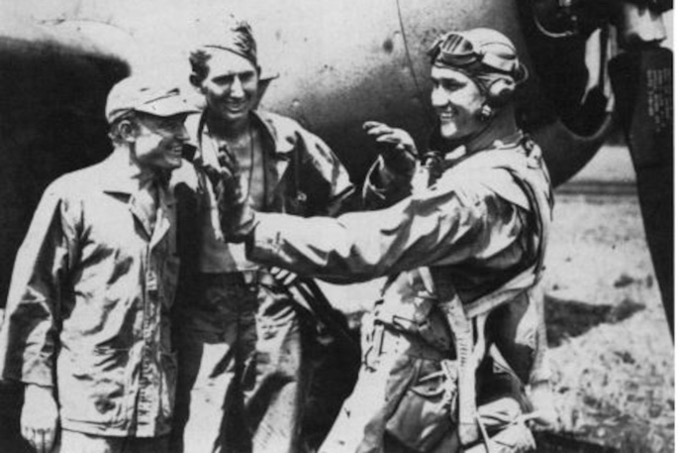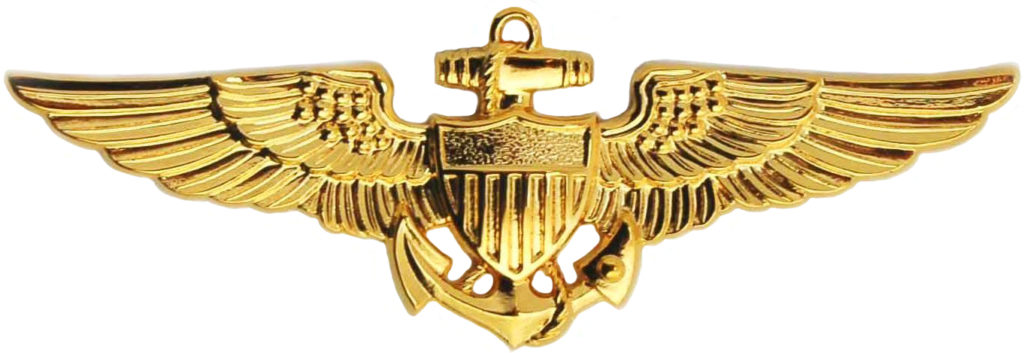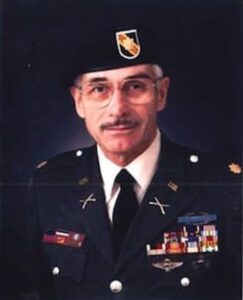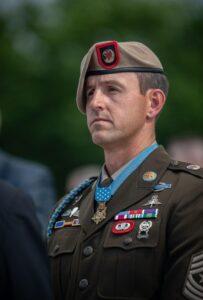- Date of Action: October 16, 1942
- Squadron: Marine Fighting Squadron 212 (VMF-212)
- Location: Near Guadalcanal Island

Harold “Joe” Bauer graduated from the United States Naval Academy in 1930 and earned his pilot wings as a Marine Corps aviator in February 1936. Considered one of the most experienced and capable fighter pilots in the Corps, Major Bauer was assigned the task of standing up and commanding a new squadron—Marine Fighting Squadron 212 (VMF-212)—shortly after the attack on Pearl Harbor. Quickly promoted to Lieutenant Colonel, Bauer and his aviators deployed to New Caledonia in the South Pacific in April of 1942.
On a visit to Guadalcanal on September 28, 1942, Bauer asked to borrow one of Bob Galer’s Wildcats from VMF-224, stationed at Henderson Field. Bauer took to the air and promptly shot down a Japanese G4M “Betty” bomber. Returning on October 1, 1942, Bauer borrowed another Wildcat—this time from future Medal of Honor recipient, John Smith of VMF-223—and shot down four Japanese Zero fighters in a wild dogfight near Guadalcanal.
Known as “Indian Joe” or “Coach”, Bauer was not only a great fighter pilot but also a tremendous leader. Unlike others who sought to avoid combat with the vaunted Japanese Zero fighter, the ever-aggressive Bauer would tell his men to dogfight the Zero whenever given the chance. He based this advice on his knowledge of the Zero’s vulnerability to gunfire and his belief that there were few good Japanese aviators left after all their losses in 1942.
On October 16, 1942, Lt. Col. Bauer was leading a flight of Wildcats to Guadalcanal as reinforcements for the “Cactus Air Force” located at Henderson Field. After nearly 600 miles of flying from their base at Espiritu Santo, the Wildcats, with their fuel tanks nearly empty, looked to land at Henderson Field. Bauer noticed that a group of Japanese Aichi D3A Type 99 “Val” dive bombers attacking the submarine-tender USS McFarland (AVD-14). The McFarland had been towing a barge filled with much-needed aviation gasoline to Guadalcanal. One of the Japanese bombs struck the fuel-filled barge and created a huge fireball of burning gas. Bauer, undeterred by his low fuel state, dove his Wildcat down to just a few hundred feet above the water and attacked the Japanese formation. Maneuvering in and around the slower dive-bombers, Bauer claimed that he shot down four of the attackers.

Bauer’s impressive fighter skills and natural leadership skills led to his being named commander of all fighter operations from Henderson Field on Guadalcanal. Despite his increased responsibilities, Bauer never shirked from flying the most challenging missions. On November 14, 1942, he lifted off from Henderson Field to take a closer look at an incoming convoy of Japanese warships and transports. As Bauer provided cover for the American dive bombers and torpedo bombers headed for the convoy, he encountered a force of Japanese Zeros, intent on defending the ships below. In the wild melee, Bauer shot down two of the Japanese fighters before his own plane was hit by enemy fire. Other Wildcat pilots, including future Medal of Honor recipient Joe Foss, saw Bauer in the water with his Mae West life vest inflated. Foss and another pilot quickly jumped into a J2F Duck aircraft and flew back to Bauer’s location. They searched but could not find Bauer. With his fate uncertain, Bauer was listed as missing in action and his death was not officially confirmed until after the end of World War II.
While Secretary of the Navy Frank Knox had approved Joe Bauer’s Medal of Honor award in May of 1943, Bauer’s wife refused to accept the medal until it was certain that her missing husband was dead. After the war’s conclusion and Bauer’s fate was certain, the posthumous medal was accepted by Bauer’s widow and son on May 11, 1946.
Medal of Honor Citation
For extraordinary heroism and conspicuous courage as Squadron Commander of Marine Fighting Squadron 212 in the South Pacific area during the period from 10 May to 14 November 1942. Volunteering to pilot a fighter plane in defense of our positions on Guadalcanal, Lt. Col. Bauer participated in two air battles against enemy bombers and fighters outnumbering our force more than two to one, boldly engaged the enemy, and destroyed one Japanese bomber in the engagement of 28 September, and shot down four enemy fighter planes in flames on 3 October, leaving a fifth smoking badly. After successfully leading 26 planes on an over-water ferry flight of more than 600 miles on 16 October, Lt. Col. Bauer, while circling to land, sighted a squadron of enemy planes attacking the U.S.S. McFarland. Undaunted by the formidable opposition and with valor above and beyond the call of duty, he engaged the entire squadron and, although alone and his fuel supply nearly exhausted, fought his plane so brilliantly that four of the Japanese planes were destroyed before he was forced down by lack of fuel. His intrepid fighting spirit and distinctive ability as a leader and an airman, exemplified in his splendid record of combat achievement, were vital factors in the successful operations in the South Pacific area.




